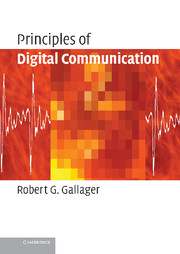Book contents
- Frontmatter
- Contents
- Preface
- Acknowledgements
- 1 Introduction to digital communication
- 2 Coding for discrete sources
- 3 Quantization
- 4 Source and channel waveforms
- 5 Vector spaces and signal space
- 6 Channels, modulation, and demodulation
- 7 Random processes and noise
- 8 Detection, coding, and decoding
- 9 Wireless digital communication
- References
- Index
6 - Channels, modulation, and demodulation
Published online by Cambridge University Press: 05 June 2012
- Frontmatter
- Contents
- Preface
- Acknowledgements
- 1 Introduction to digital communication
- 2 Coding for discrete sources
- 3 Quantization
- 4 Source and channel waveforms
- 5 Vector spaces and signal space
- 6 Channels, modulation, and demodulation
- 7 Random processes and noise
- 8 Detection, coding, and decoding
- 9 Wireless digital communication
- References
- Index
Summary
Introduction
Digital modulation (or channel encoding) is the process of converting an input sequence of bits into a waveform suitable for transmission over a communication channel. Demodulation (channel decoding) is the corresponding process at the receiver of converting the received waveform into a (perhaps noisy) replica of the input bit sequence. Chapter 1 discussed the reasons for using a bit sequence as the interface between an arbitrary source and an arbitrary channel, and Chapters 2 and 3 discussed how to encode the source output into a bit sequence.
Chapters 4 and 5 developed the signal-space view of waveforms. As explained in those chapters, the source and channel waveforms of interest can be represented as real or complex ℒ2 vectors. Any such vector can be viewed as a conventional function of time, x(t). Given an orthonormal basis {ϕ1(t), ϕ2(t), …} of ℒ2, any such x(t) can be represented as
Each xj in (6.1) can be uniquely calculated from x(t), and the above series converges in ℒ2 to x(t). Moreover, starting from any sequence satisfying Σj|xj|2 < ∞, there is an ℒ2 function x(t) satisfying (6.1) with ℒ2-convergence. This provides a simple and generic way of going back and forth between functions of time and sequences of numbers.
- Type
- Chapter
- Information
- Principles of Digital Communication , pp. 181 - 215Publisher: Cambridge University PressPrint publication year: 2008



